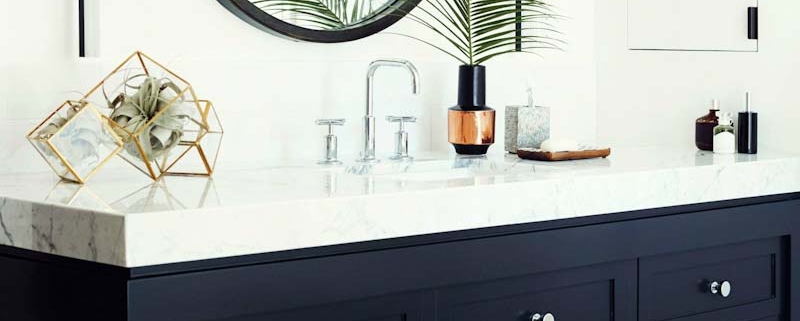Choose Bathroom Countertop Material for Your House
One of the most enjoyable home renovation tasks you can do is to renovate your bathroom. When renovating a tiny area, you get a lot more for your money, and the remodeling process is frequently much faster than it would be for a bigger job such as upgrading the kitchen. The best part is that bathroom remodels are likely to increase the value of your house, making it a project you can feel good about investing in.
Your bathroom countertops are a crucial issue when planning your next bathroom makeover, so make sure you take them into account. The material you choose may significantly influence the final result, so it’s critical to understand your options. Whether you plan a grand makeover or you are looking for affordable bathroom remodel ideas, stick around to read about all the different countertop materials available to you.
Wood Bathroom Countertop
Wood countertops are a great way to provide warmth and a rich sense to your bathroom without breaking the bank. You can be sure that when your guests walk into your freshly renovated bathroom, they will be impressed by the change. Wood bathroom countertops add a level of elegance to your bathroom, are eco-friendly, and slow the growth of bacteria. Add to that the fact that wood countertops are warm to the touch, and they can easily seem like the perfect choice.
Wood is a beautiful addition, both in terms of appearance and feel. However, there are some downsides you need to be aware of. For starters, wood is high maintenance. A wood countertop requires regular oiling and sealing to protect against moisture damage, scratches, and stains. Even when the correct precautions are taken, wood countertops are prone to scratches, dents, and water damage. For a responsible user, none of these issues should be a problem. But if you are someone who wants to buy their countertop and never worry about any maintenance, then check out some of the other options.
Granite Bathroom Countertop
Granite bathroom countertops are the most popular choice of countertop material. It is a natural stone with a luxurious look and is available in a range of various styles. Granite is incredibly robust; it can withstand high temperatures, stains, and scratches without breaking down.
On the other hand, granite is not very water-resistant. This material is highly adept at absorbing moisture, increasing the potential of damage and bacteria accumulation. That means you will need to seal it and make sure you don’t let water pool on it, or you might have a problem on your hands.
Marble Bathroom Countertop
If you’re searching for something a little more exquisite and one-of-a-kind, marble could be the ideal choice. An exciting characteristic of marble bathroom countertops is that each slab is unique, and will make a dramatic statement in your bathroom. Marble worktops are durable and have solid surfaces. In addition, you can further personalize your marble countertop by choosing from a variety of colors that will surely wow your guests.
One of the disadvantages of marble is that it is not very resistant to wear and tear and will need regular care. It is necessary to seal your marble countertops when you install them initially and then reseal them every few years afterward to avoid stains. Marble countertops are more porous than granite counters, which means that any liquids that penetrate this natural stone would be very difficult to remove from the surface. Marble is also more expensive than granite, so you can expect to spend a little extra if you choose this gorgeous material for your countertops.
Tile Bathroom Countertop
Bathroom countertops made of ceramic or porcelain tile are a great choice. Although, they are frequently overlooked these days. When it comes to bathroom renovation, tile bathroom countertops used to be widely used decades ago, but the emergence of stone bathroom countertops has driven this trend into the ground.
Tile countertops made of ceramic or porcelain are a fascinating and distinctive alternative, particularly for a classic home or a farmhouse design. They are simple to install, and readily available at reasonable prices at most hardware stores. Tiled countertops are a terrific alternative for creating an old-world feel in your new bathroom.
How to Replace Bathroom Countertop
The first thing you need to do is remove your old countertop. It’s relatively straightforward because all you need to do is cut through the caulk around the edges, and lift it and take it off. Be aware that countertops are generally very heavy, and it is not advisable to attempt to remove them alone. Next, measure and cut the new countertop as well as a hole for the sink. Then install it and caulk around the edges.
Of course, the best way to replace your bathroom countertop is to call in a bathroom remodeling expert. That way, you can know that a professional will take care of the job correctly, and you will have a beautiful new countertop installed in no time.
Conclusion
Your choice of vanity top material is a matter of personal preference. Begin by identifying the things that are most important to you. Is it the aesthetic, the durability, or the price?
Understanding what your goals are for your bathroom will narrow down your options and make the choice much easier. With the information provided in this guide, you should have everything you need to get started. Happy remodeling!





